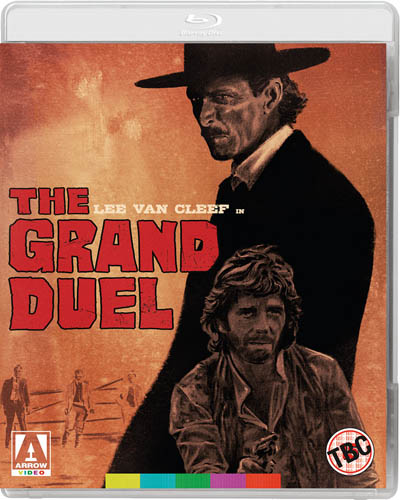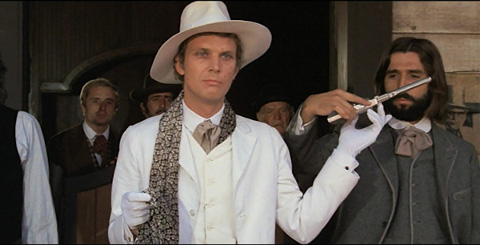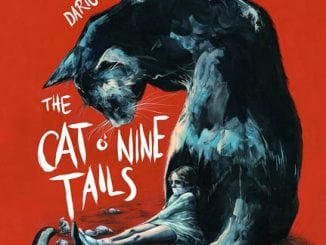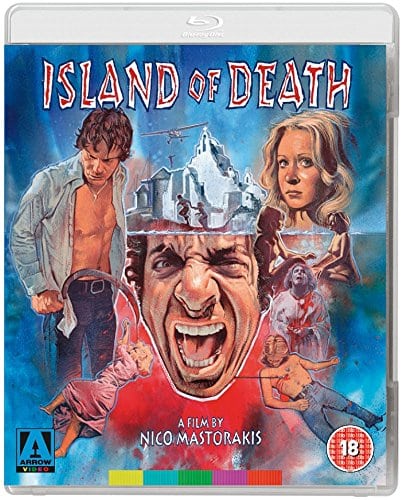The Grand Duel (1972)
Directed by: Giancarlo Santi
Written by: Ernesto Gastaldi
Starring: Alberto Dentice, Horst Frank, Jess Hahn, Lee Van Cleef
AKA IL GRANDE DUEL, THE BIG SHOWDOWN, STORM RIDER
Italy/West Germany/France
AVAILABLE ON BLU-RAY: NOW, from ARROW VIDEO
RUNNING TIME: 98 mins
REVIEWED BY: Dr Lenera, Official HCF Critic
Philip Wermeer has been framed for the murder of a powerful figure known as The Patriarch. Wermeer escapes, but the three Saxon brothers, sons of The Patriarch, have arranged for a large bounty on Wermeer’s head. Clayton is a grizzled ex-sheriff stripped of his office in Jefferson after refusing to acknowledge Wermeer’s guilt. He tracks down Wermeer, saves him from some bounty hunters and takes him as his own prisoner even though he soon reveals that he knows Wermeer is innocent. The two head for Saxon Town where they are most certainly not welcome….
I guess The Grand Duel is best known to many for its main music theme by Luis Bacalov which was used during the anime-style Origins of O-Ren Ishii segment from Kill Bill Vol. 1. The very emotive Ennio Morricone-style piece really added to the tragedy of what we were seeing on screen. Apparently Quentin Tarantino really loves the actual film of The Grande Duel too, and now I’ve finally seen it, I can see why. This is an absolutely cracking spaghetti western with loads of action, some great characters, a pretty strong plot which works as a proper mystery, and Lee Van Cleef at his very coolest – even if characters can’t seem to decide if he’s a Marshall or a Sheriff. Despite being obviously much lower budgeted, it does look and feel like a Sergio Leone film in places, something that’s hardly surprising seeing as director Giancarlo Santi worked as an assistant director on two of Leone’s pictures and started to direct A Fistful Of Dynamite until replaced by Leone, though Santi does have a few of his own stylistic quirks. Some might find the light tone of many of the scenes and the goofy humour clashing with the seriousness of the plot and scenes where, for example you get the obligatory beating [though even here the comment “you keep hitting him in the mouth he won’t be able to talk” causes a chuckle in context] and men, women and children gunned down in a massacre. But you tend to get a bit of jokery in most of these films – surely one reason for The Good The Bad And The Ugly‘s enduring popularity is that despite all its brutality it’s often hilarious.
So how cool is Van Cleef in this one? Well, let’s look at the fantastic opening scene, where some, but not all [the rest come at the end] of the credits take place over shots of a tiny village named Gila Bend which set a calmly suspenseful mood. Arriving at the village is a stagecoach containing five passengers: a caretaker named Borghesi, an unnamed [for now] older lady, two younger girls Elisabeth – who’s on her way to marry into the Saxon family – and Anita, plus – Sheriff Clayton. Van Cleef has a superb intro, sitting with his head down so we just see his hat until his features are revealed as he gives that Look, then steps out of the carriage, calmly walks towards the man who’s pointing a gun at him, hooks his bag onto the guy’s gun then also places his coat over it, opens the bag, takes out his own gun – then strides off! Then, because he knows that Vermeer is hiding inside, he very casually shows Vermeer where some bounty hunters are hidden – like throwing a lit match so a man hidden in hay has to put it out – calmly sits down in the minute saloon to have a whisky and a slice of cake “without the filling” – then goes upstairs to where Vermeer is and doesn’t seem to be bothered at all when Vermeer holds a gun to his head. Even Clint couldn’t have pulled off this stuff as well. Gunfire results, and even more bounty hunters show up. In the midst of the fray we get a really bizarre WTF moment that I had to rewind to view again just to see if I hadn’t just imagined it. Vermeer jumps onto the tow bar of a horse cart and allows the weight distribution prompted by the falling body of a shot bounty killer to catapult him over the top of a high building. As he falls to earth on the other side of the building, Vermeer arches his body and shoots a second bounty killer that was waiting for him there. That bounty killer falls from his vantage point and lands on a third bounty killer, temporarily incapacitating him!
When everyone’s gone or is dead, the townsfolk come out of hiding to go about their daily business, completely ignoring the dead bodies being dragged away in the distance. It’s amusing, but perhaps also realistic if you think about it. The inhabitants, who have previously been unseen, are probably used to all this. Anyway, during the battle, Wermeer jumps up on a horse and escapes, pursued by the survivors except for Clayton. He makes the bounty hunters follow his horse, then hitches a ride with the stagecoach, where he finds – Clayton, among the same passengers as before. The caretaker and the older lady’s snobby comments throughout their journeying are amusing and the revelation of whom two of the characters turn out to be later is a nice surprise. The group stay the night at Silver Bells Inn where Wermeer keeps trying to escape, Elisabeth shows an interest in him, and the drunken stationmaster and the driver play checkers with shots of spirits. It really is quite picaresque for some time but the tone does get darker as we get to Saxon Town and the murderous Saxons are introduced, and the issue of the Patriarch comes to the fore – though you still get odd touches like one of the most memorable bad guys I’ve seen in a while. Klaus Grunberg plays Adam Saxon, a murderous homosexual with syphilitic [I think] spots on his face who wears a white suit, fedora, and constantly caresses a long scarf looped around his neck [imagine the whinging from the PC mob if this film came out today]. He guns down an old man in a scene clearly influence by a similar one in Shane and the dying man leaves the imprint of a bloody hand on his shirt, something which seems to give Adam a blatantly sexual thrill. The hand imprint bit was cut from the original English language release and wasn’t in the first DVD release either. Why I don’t know, it’s hardly shocking and may have just been considered too ridiculous, though it’s nowhere near as ridiculous as Clayton catching a bullet with his teeth, even if we only see the aftermath of said event, and Van Cleef is so damn awesome that he’s able to almost convince us that his character is able to do such a thing.
Of course it all ends in a big showdown, here in a series of huge cattle pens, which has a clever finish, though Santi really piles on the Leone touches like quick close-ups. He comes into his own though during the very noir-ish black and white flashbacks to the killing of the Patriarch where train smoke obscures some of the action and more is revealed each time, though the film does a strange thing here by showing us the darkened outline of the killer very early. The camera finally tracking into the silhouette of this person whom we can recognise [even though his or her facial features aren’t visible] would be a really great cinematic moment that people might be talking about if we didn’t already know who it was – but the idea was probably to provide an early shock and get us to wonder “why”? rather than “who”? I do wonder if screenwriter Ernesto Gastaldi, known from many gialli, originally intended the revelation to be a proper mystery and it was Santi who made the change. Realism isn’t always something they seemed to go for with this film, what with its happy hookers straight out of the ‘70s – and as for the hairstyles and even some of the costumes [did they really have Gucci back then?] – well, there’s little attempt at hiding when this was made. Philipp Vermeer is kind of hippy-ish and counter-cultural in appearance and outlook, you can see Peter Fonda fitting perfectly into the part, though ‘Peter O’Brien’ [real name Alberto Dentice] does have the required charisma. Giallo fans will recognise Horst Frank in not one but two roles, while a few familiar Leone faces can be spotted also. As for Van Cleef, here he gets to play the older gunfighter who has a like/dislike relationship with a younger gunfighter once again, a role which of course began in For A Few Dollars More [he’d retired from the screen for many years and was living as a painter before Leone tracked him down], and sporting a familiar outfit and that pipe. But he seems to be having even more fun than normal here.
There are a few instances of sloppy editing from scene to scene, and you’ll laugh at how the stuntmen jump in the air as they’re playing at being shot. You’ll also recognise the main town set from scores of other spaghetti westerns, but it’s a good one so why not? Sometimes Santi can’t quite disguise the low budget, but when a few issues can mostly be put down to a quick shooting schedule and limited funds, they can’t really be blamed on the filmmakers, and the film does usually look good, largely courtesy of Mario Volpiani’s fine cinematography which employs a lot of deep focus shots. But the music score, credited to a Sergio Bordotti but seemingly mostly written by Bacalov, seemed a little ‘off’ to me, not always fusing with what was happening on screen very well. Maybe I’m saying this because I first heard it in Kill Bill, but that main theme seemed rather too romantic and emotional to me to accompany build-ups to gunfights, while some action moments are irritatingly scored by a hoe-down style piece. A couple of scenes are accompanied by an old folk tune, but I couldn’t recall nor find out for the life of me what it was!
In the end though, The Grand Duel really works as a fun and even sometimes unpredictable melding of the familiar with dashes of the unfamiliar in its genre. It ain’t dull for a minute, yet the plot with just a bit of tweaking would work in a modern-set film with far less action. While I’m typing the main part of this review before I start to go through the special features on the Blu-ray, I would imagine that it was probably dismissed in its time as another routine Latin oater in most countries, while in its native Italy it came out at a time when comedic westerns where the violence was slapstick in nature were all the rage – yes, there’s humour in this film – but there’s also much seriousness. I actually think that it’s one of the last of the really good spaghetti westerns, and even possibly the best [okay, I haven’t seen them all] of the many ones Van Cleef made after his Leone’s. And Van Cleef is every bit as cool as Clint Eastwood or Franco Nero here, deserving of some genuine reappraisal as one of the great action stars of the screen.
Rating: 









This Region ‘A’ and ‘B’ release represents The Grand Duel‘s third release on Blu-ray, though the first one on Region ‘B’. The 2k restoration was done by L’Immagine Ritrovata but Arrow seem to have done their own tweaking as there’s very little of the annoying yellow emphasis you often get from that company’s restorations – or maybe L’Immagine Ritrovata are getting better as there does seem to have been a considerable improvement in their output of late. For the most part the picture is great, though those who don’t like grain [I like it myself, as it reminds me that I’m watching something shot on celluloid] may not agree even though it’s mostly evenly distributed. Depth and clarity is mostly fine too. However, there are a few shots, usually involving close-ups, where the quality dips, the picture becoming soft and brownish. This is possibly down to poor/damaged source elements that not too much could be done with. I watched the film with the English track for the most part, occasionally switching over to the Italian for comparison, as many of the cast members seem to be speaking English. The music is more to the fore in the Italian and the dialogue quieter. Lip-synching is often noticeably poor, but of course that could not be improved! The Italian opening and closing credits are also different from the English.
Arrow have really treated fans of a film which has previously had no special features except for an audio commentary on the Blue Underground Blu-ray. Arrow begin by giving us a different commentary. Stephen Prince sometimes tells us what’s happening on screen, but generally he provides a very fine track, some of its information providing to Prince by Santi himself. He identifies locations, comments on the filming style, gives a good overview of Van Cleef’s career but stops short of listing everyone’s film credits like some commentators feel they have to, and even fills in on what could be missing elements of the plot that are just vaguely suggested. He also describes a nasty horse fall that we don’t actually see in the UK release because it’s been cut by the BBFC. Often technical but never dry, it’s so good that it would probably have sufficed as the sole special feature. But Arrow have given us more.
The interviews begin with An Unconventional Western, featuring a nicely candid and opinionated Santi. Hear how Cleef was such great value because he was cheap yet popular, how Bardotti actually did the score [well, according to Santi], how he added much of the humour, and how Tarantino’s use of the music was “outright theft”. A typically loud and animated Gastaldi begins The Last of the Great Westerns by saying “obviously I’ve only seen the film once”, and then how he can’t remember much except how Santi imitated Leone. But he does seem to remember a lot about Leone, My Name Is Nobody which he also scripted, and a modern-set western-style screenplay he wrote that was never filmed, as well as waxing nostalgic for the glory days of Italian cinema which countless westerns were churned out every year and producers bought western scripts without even reading them. Cowboy by Chance has actor Alberto Dentice chat in great detail about his short but interesting career that also includes some unusual stage work. He says how he broke an arm on The Grand Duel and hated one scene that he had to do. Out of the Box has producer Ettore Rosboch discuss how the production was set up and relates a few stories from the set. I found all these interviews especially interesting for the tidbits about Van Cleef. Here, you learn that he was afraid of horses! The Day of the Big Showdown is assistant director Harald Buggenig with some more stories [the guy who played the station master had to be kept away from the bottle!], and saying how he did various production duties. Saxon City Showdown has academic Austin Fisher place the film in context, with some particularly interesting stuff about the often negative portrayal of the law and modernism in some of these films. Two Different Duels visually compares the version of the film we have on this disc with a longer German cut which couldn’t be restored. Most of the differences amount to tiny scene extensions, but the beating and massacre are longer and you get to see an extra flashback. I think the film would be better with this material in. And finally we get two extras included late in the day – Marc Mazza: Who was the Rider on the Rain?, a somewhat tongue in cheek look at the actor whose career consisted mainly of bit parts though he got to shine in The Grand Duel, and Game Over, a strange sci-fi short starring Mazza. Some may wonder why the latter was included, but I love the way Arrow often tend to pile on the special features, it just adds value in my opinion.
An archetypal spaghetti western just a hair breadth away from being a genuine classic of the genre, in a well packed release of the quality we’ve come to expect from Arrow – Highly Recommended.
SPECIAL EDITION CONTENTS
*New 2K restoration from the original 35mm camera negative
*High Definition Blu-ray™ (1080p) presentation
*Uncompressed mono 1.0 LPCM audio
*Original English and Italian soundtracks, titles and credits
*Newly translated English subtitles for the Italian soundtrack
*Optional English subtitles for the deaf and hard of hearing for the English soundtrack
*New audio commentary by film critic, historian and theorist Stephen Prince
*An Unconventional Western, a newly filmed interview with director Giancarlo Santi [31 mins]
*The Last of the Great Westerns, a newly filmed interview with screenwriter Ernesto Gastaldi [25 mins]
*Cowboy by Chance, an interview with the actor Alberto Dentice AKA Peter O’Brien [35 mins]
*Out of the Box, a newly filmed interview with producer Ettore Rosboch [29 mins]
*The Day of the Big Showdown, a newly filmed interview with assistant director Harald Buggenig [21 mins]
*Saxon City Showdown, a newly filmed video appreciation by the academic Austin Fisher [15 mins]
*Two Different Duels, comparison of the original Italian version and the longer German version [15 mins]
*Marc Mazza: Who was the Rider on the Rain?” documentary by Mike Malloy [12 mins]
*Game Over, 1984 short sci-fi film directed by Bernard Villiot and starring Marc Mazza [9 mins]
*Original Italian and international theatrical trailers
*Extensive image gallery featuring stills, posters, lobby cards and home video sleeves, drawn from the Mike Siegel Archive and other collections
*Reversible sleeve featuring original and newly commissioned artwork by Matt Griffin








Be the first to comment